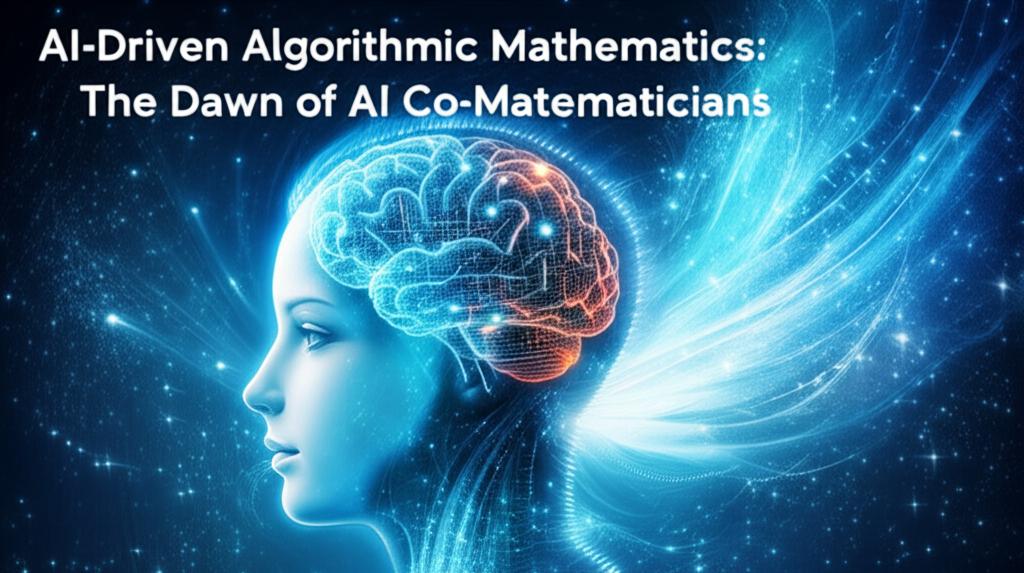The realm of mathematics, traditionally seen as a uniquely human domain of abstract thought and rigorous proof, is standing on the precipice of a profound transformation. Artificial intelligence (AI) is rapidly emerging not just as a powerful computational tool, but as a genuine collaborator, an "AI co-mathematician." This new partnership is set to revolutionize how mathematical research is conducted, accelerating discoveries and potentially unlocking entirely new fields of inquiry.
At the heart of this evolution is AI's remarkable ability to identify intricate patterns and relationships within vast datasets, a feat that can often elude human researchers. Machine learning algorithms, particularly deep learning, are being harnessed to analyze complex mathematical structures, leading to breakthroughs in areas once considered solely the territory of human intuition. For instance, AI has already demonstrated its prowess by predicting the rank of elliptic curves—a significant problem in number theory—and has even autonomously generated novel formulae for fundamental constants. Google DeepMind's research into knot theory using neural networks has further revealed unexpected connections between algebraic and geometric structures.
The concept of an "AI co-mathematician" extends beyond mere pattern recognition. AI systems are increasingly capable of assisting in the development and verification of mathematical proofs. Tools like Lean, an AI-powered proof assistant, are enabling mathematicians to formalize complex proofs, including long-standing conjectures. This not only enhances the rigor of mathematical work but also frees up human mathematicians to focus on the more creative and conceptual aspects of their research. Imagine AI tirelessly exploring vast proof spaces or meticulously checking every step of a complex argument, allowing its human counterpart to strategize and guide the overall direction of discovery.
Furthermore, AI is democratizing access to specialized mathematical knowledge. By providing intuitive explanations of complex concepts and assisting in navigating dense academic literature, AI can significantly lower the barrier to entry for researchers looking to explore new mathematical fields. This could foster greater interdisciplinary collaboration and spark innovation at the intersection of different mathematical disciplines. AI-driven platforms are also enhancing collaborative problem-solving within the mathematical community, facilitating more efficient discussions and the cross-pollination of ideas.
The implications of AI co-mathematicians are far-reaching. Programs like DARPA's Exponentiating Mathematics (expMath) initiative actively seek to develop AI systems that can act as "co-authors," helping to break down complex problems into more manageable components and accelerating the overall pace of discovery. This heralds a future where human-AI collaboration becomes the norm, leading to a more experimental and dynamic approach to mathematics. AI could propose novel conjectures, test hypotheses at an unprecedented scale, and even help design new mathematical frameworks.
Of course, the rise of AI in mathematics also presents challenges. The "explainability gap" of some AI-generated proofs – difficulty in translating them into human-understandable arguments – needs to be addressed. Ensuring that AI can acquire deep domain-specific expertise and learn from the iterative, often trial-and-error, process of mathematical discovery are ongoing areas of research.
Despite these hurdles, the trajectory is clear: AI is poised to become an indispensable partner in the quest for mathematical understanding. This isn't about AI replacing human mathematicians, but rather augmenting their capabilities, fostering a synergistic relationship where human intuition guides AI's powerful analytical abilities. The dawn of AI co-mathematicians promises an exciting new era of accelerated discovery, deeper insights, and a fundamentally transformed mathematical landscape. The potential for AI to help unravel some of the most profound mysteries of the universe, encoded in the language of mathematics, is only just beginning to unfold.

